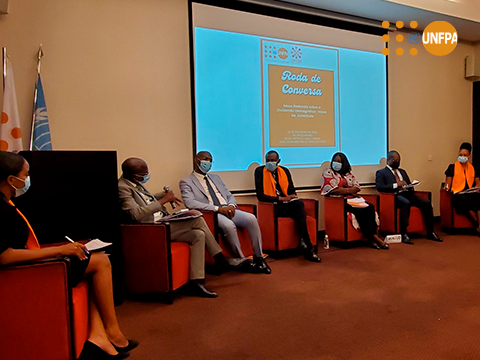Demographic Dividend Discussion Round “Voices of Youth”
In order to disseminate part of the study carried out by the Government of Angola through the Ministry of Economy and Planning (MEP), on Harnessing the Demographic Dividend of Angola in 2019, through the report on the theme: Harnessing the Potential of Youth to Harvest the Demographic Dividend in Angola, UNFPA interns held on February 22 the Round of Talks the "Voice of Youth".
The interns from the Population Dynamics area, supervised and guided by UNFPA Angola Representative Professor Dr. Mady Biaye and by Mrs. Laura Devos, Strategic Information Specialist of UNFPA Angola, led the initiative in order to reflect on the current state of the Demographic Dividend in Angola, and promote the commitments made by the country at the ICPD25 Summit in Nairobi.
Angola's demographic profile is characterized by rapid population growth, which results in a very young age structure. The data from the INE (National institute for Statistics) population projections, indicate that the population in 2021 stands at 32.1 million inhabitants, accompanied by one of the highest fertility rates in sub-Saharan Africa, with an average of 6.2 children per woman at national level, being higher in rural areas (8.2 children) and 5.3 children in urban areas, according to data from the (IIMS, 2015-2016). Demographic projections show that in the coming years Angola's population will continue to grow at a very fast pace, and may reach about 41.8 million inhabitants in 2030. If this scenario is maintained at the current rate of growth, the country could reach 101.2 million inhabitants in 2054.

The idea for an open dialogue arose from the pressing need for all sectors, at all levels, to be informed about the results of the Demographic Dividend in light of the commitments made at the ICPD25 Summit in Nairobi, to ensure collaborative efforts and achieve the strategic objectives defined. The event was attended by representatives of the following Ministries: Economy and Planning, Education, Youth and Sports, Social Action, Family and Promotion of Women in addition to the National Institute of Statistics and civil society groups, namely, AfriYAN, CICA, C.A.J, Youth Arm of the Casa-CE, JFNLA, JMPLA and JURA.

"The information contained in the Multiple Health Indicators Survey (IIMS, 2015-2016) can be used for us to assess the current situation of some key indicators for the effectiveness of the Demographic Dividend. Without key information on relevant health indicators, the country cannot adequately measure the situation or monitor progress. What challenges may arise from not conducting the IIMS in 2020? And how much is the data collection phase planned for the next IIMS?" as one of the questions posed by youth through João Domingos, UNFPA Population Dynamics Intern, to the roundtable panelists.



